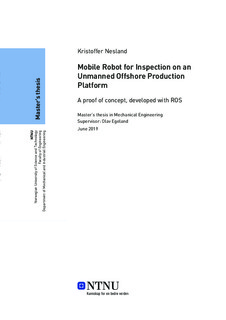| dc.contributor.advisor | Olav Egeland | |
| dc.contributor.advisor | Gunleiv Skofteland | |
| dc.contributor.author | Kristoffer Nesland | |
| dc.date.accessioned | 2019-10-19T14:00:59Z | |
| dc.date.available | 2019-10-19T14:00:59Z | |
| dc.date.issued | 2019 | |
| dc.identifier.uri | http://hdl.handle.net/11250/2623320 | |
| dc.description.abstract | Oppdagelser av nye offshore olje og gass felter lokalisert langt fra kysten byr på nye utfordringer for industrien. Transportkostnader øker i takt med økt avstand til land og risikoen ved å stasjonere mennesker langt ut på havet er betydelig. Dette inviterer til nytenking innen bransjen. Ubemannede offshore produksjonsplattformer kan være løsningen på de nevnte utfordringene. Allikevel så vil det være umulig å designe en helt vedlikeholdsfri plattform. Det er her ideen om en mobil inspeksjon- og vedlikeholdsrobot kommer inn. Ved riktig design skal en robot kunne redusere behovet for menneskelige inngrep på plattformen og la operatører bli værende på land så lenge som mulig.
Denne oppgaven fokuserer i hovedsak på inspeksjonsegenskapene til en mobil robot. Robot Operating System (ROS) blir tatt i bruk sammen med den mobile roboten TurtleBot3 for å eksperimentere med metoder for deteksjon av gasslekkasjer og uønskede fysiske gjenstander på plattformen. Den implementerte funksjonaliteten blir testet gjennom eksperimenter i et rom innredet for å etterlikne noen av trekkene man vil finne igjen på en ubemannet produksjonsplattform. Planlegging av rute og utførelse er oppnåd med ROS Navigation stack og en rekke eksperimenter er utført for å teste ytelsen til denne programvaren i omgivelser som vil være relevante for en inspeksjonsrobot på en offshore plattform. Som man kan forstå ut i fra dette, så vil fokuset være på design av programvare, ikke på det fysiske deignet av roboten.
Testing av de implementerte funksjonene i denne oppgaven viser oppløftende resultater. Roboten er i stand til å generere et kart over gass-konsentrasjon basert på simulerte målinger. Også den nyutviklede metoden for å detektere hindringer ser ut til å fungere bra og systemet var i stand til å detektere 17 av 19 hindringer med en nøyaktighet på dårligst 0.3 m, gitt data fra robotens LiDAR. Det må merkes at testene er gjennomført i et kontrollert miljø og mange uforutsette utfordringer kan vise seg på en ekte plattform. Alt i alt så fungerer oppgaven som et ``proof of concept'' og belyser noen nyttige funksjoner som kan raskt utvikles i ROS, gitt en mobil robot med LiDAR, kameraer og gass-sensor. | |
| dc.description.abstract | Discoveries of offshore oil and gas reservoirs far from the shore, present new challenges for the industry. Transportation costs increase as the distance to the coastland increases and the risk of stationing human operators far out in the sea is considerable. This calls for new thinking in the industry. Unmanned offshore production platforms can be the solution to the mentioned challenges. However, to design a totally maintenance free platform is impossible. This is where the idea of a mobile inspection and maintenance robot enters. If designed properly, it should reduce the need for human intervention on the platform and let the operators stay on the shore as long as possible.
This thesis focuses mainly on the inspection features of a mobile robot. The Robot Operating System (ROS) and the TurtleBot3 mobile robot is used to experiment with methods for detection of gas leakages and unwanted physical objects on the platform. All the implemented functionalities are verified through experiments in a room designed to replicate some of the features found on an unmanned production platform. Path planning and execution is achieved with the ROS Navigation stack and additional experiments are conducted to assess the performance of this software in an environment that will be relevant for an inspection robot on an offshore platform. As can be interpreted from this, the focus is on the software design and not the physical design of the robot.
Testing of the features implemented in this thesis show promising results. The robot is able to generate a heatmap of the gas concentration based on simulated measurements. Also the novel obstacle detection shows promise and is able to estimate the location of 17 out of 19 obstacles within 0.3 m given data from the TurtleBot's LiDAR. However, it must be taken into account that these tests are performed in a controlled environment and many unforeseen challenges may become apparent on a real platform. All in all, the thesis serves as a proof of concept and showcases some of the useful features that can be quickly developed with ROS given a mobile robot with a LiDAR, cameras and a gas detector. | |
| dc.language | eng | |
| dc.publisher | NTNU | |
| dc.title | Mobile Robot for Inspection on an Unmanned Offshore Production Platform | |
| dc.type | Master thesis | |
